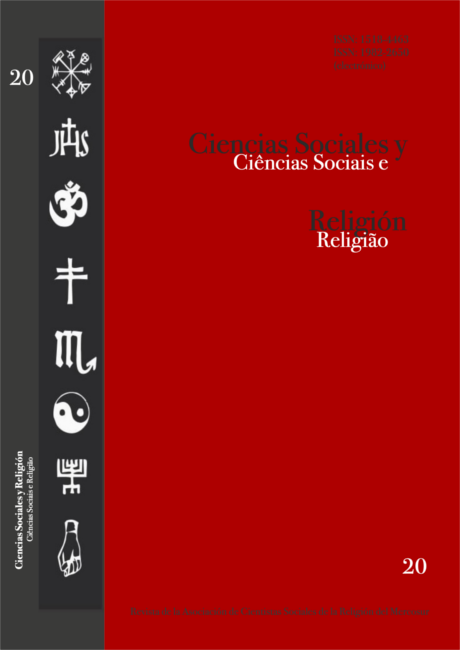Abstract
Considering that colonial festivities –that in the whole Upper Peru presented religious features-are a strategic space whereto detect the reproduction and expression of cultural values, in this paper we aim to observe and describe religious festivities that existed in Potosí during the XVIIIth century. The religious ceremonies developed in the framework of those institutions favoredthe linkages between different actors in a society where religion was the axis of daily life. Without neglecting the religious nature of such festivities, it must be taken into account that they were the scenario of significant economic and political activities -since, for example, local elections were held there-. In this spirit, we will go through the sources describing such events, aiming to understand the different contents that reflected these practices, presenting both an explicit and symbolic nature.
References
ADRIÁN, M. “El espacio Sagrado y el ejercicio del poder. Las doctrinas de Chayanta durante la segunda mitad del siglo XVIII”. En: MARTÍNEZ, J. L. (Coord.); Actas del IV Congreso internacional de Etnohistoria. Tomo I. Autoridad y Poder; Lima, Fondo Editorial Pontificia Universidad Católica del Perú. 1998.
ARGANDOÑA PASTÉN Y SALAZAR, P. M. Arancel de Derechos Parroquiales. Lima, Casa de los Niños Huérfanos. 1771.
ARGANDOÑA PASTÉN Y SALAZAR, P. M. Constituciones Sinodales del Arzobispado de La Plata. Cochabamba. Imprenta de los Amigos. 1854.
ARZÁNS DE ORSÚA Y VELA, B. Relatos de la Villa Imperial de Potosí, La Paz, Plural editores. 2009.
BOVISIO, M. A. Las huacas del NOA: objetos y conceptos. Mimeo. 2006.
BUNSTER, C. “Las autoridades indígenas y los símbolos de prestigio”. Andes No 12, Universidad Nacional de Salta. 2001.
CAJÍAS DE LA VEGA, F. “Fiestas Barrocas en Charcas”. En: CAMPOS VERA, N. (Dir.); La Fiesta. Memoria del IV Encuentro Internacional sobre Barroco. La Paz, Unión Latina, 2007. pp. 51 – 67.
CELESTINO, O. 1998. "Transformaciones religiosas en los Andes peruanos. 2: Evangelizaciones”. Gazeta de antropología, ISSN 0214-7564, no 14.
CHANCE, J. K., TAYLOR, W. T. “Cofradías and cargos: an historical perspective on the Mesoamerican civil – religius hierarchy”. American Ethnology, vol. 12 No 1, feb. 1985.
ETCHELECU, L. “Diversas formas que adopta la religión andina. Yuxtaposiciones Peligrosas”. En Hispania Sacra, LIX, 119, enero-junio 2007, pp. 293-301.
JACINTO, J. A. “Las razones políticas de la controversia conciliar sobre el probabilismo en el VI Concilio Limense”. Anuario de Historia de la Iglesia, año/vol. IX, Universidad de Navarra, Pamplona, España. 2000.
MERINO MEDINA, A. “Barroco, Fiesta, Dulce”. En: CAMPOS VERA, N. (Dir.) La Fiesta. Memoria del IV Encuentro Internacional sobre Barroco. La Paz, Unión Latina, 2007, pp. 173- 179.
MILLS, K. “’In Between’: reflexiones sobre el mestizaje cultural y la movilidad en los andes Coloniales”. En Taller El mestizaje como problema de investigación, Argentina, 18- 19 de noviembre, Universidad Nacional de Quilmes, 2004.
PEASE, F. “La religión incaica” y “Organización política incaica”. En: CARMAGNANI, M. y otros (Coord.). Para una historia de América II. Los Nudos (l), Méjico, Fondo de Cultura Económica. 1999.
PLATT, T. “The Andean Soldiers of Christ. Confraternity organization, the mass of the sun and regenerative warfare in rural Potosi (18th-20th centuries)”. En: Journal de la Société des Americanistes LXXXIII, 1987, pp. 139 a 192.
POLONI-SIMARD, J. El mosaico indígena. Movilidad, estratificación social y mestizaje en el corregimiento de cuenca (Ecuador) del siglo XVI al XVIII. Quito, ABYA-YALA, 2006.
SAIGNES, T. Borrachera y memoria. La experiencia de lo sagrado en los Andes. La Paz – Lima, ISBOL. IFEA. 1993.
SARDO, E. “El derecho de autonomía: la disputa entre dos cofradías nativas en el Potosí colonial”. En: SALMÓN, J. Y DELGADO, G. (Eds.); Estudios Bolivianos, Volumen I: Identidad, ciudadanía y participación popular, desde la Colonia al Siglo XX; La Paz, Plural editores. 2007.
SERULNIKOV, S. “Las proezas de la Ciudad y su Ilustre Ayuntamiento”: Simbolismo político y política urbana en Charcas a fines del siglo XVIII”. En: Latin American Research Review, Vol. 43, No. 3. © 2008 by the Latin American Studies Association, 2008, pp. 137- 164.
SERULNIKOV, S. “Legitimidad política y organización social en las comunidades indígenas de la provincia de Chayanta (siglo XVIII)”. En: Anuario de Estudios Americanos Tomo 61, 1, Universidad de Boston. 2004.
SERULNIKOV, S. Conflictos Sociales e insurrección en el mundo colonial andino. El norte de Potosí en el Siglo XVIII, Argentina, Fondo de Cultura Económica. 2006.
SIGAUT, N. “La fiesta de Corpus Christi y la representación de los sistemas visuales”. En CAMPOS VERA, N. (Dir.); La Fiesta. Memoria del IV Encuentro Internacional sobre Barroco. La Paz, Unión Latina, 2007, pp. 123 – 134.
SIRACUSANO, G. “Notas para detener el “escándalo”: Fiesta e idolatría en el Virreinato del Perú”. En: CAMPOS VERA, N. (Dir.); La Fiesta. Memoria del IV Encuentro Internacional sobre Barroco. La Paz, Unión Latina, 2007, pp. 113- 121.
ZANOLLI, C. E. “Entre la coerción, la oportunidad y la salvación. Las cofradías de indios de San Antonio de Humahuaca. Siglos XVII y XVIII”. Andes n.19 Salta ene./dic. 2008, versión On-line ISSN 1668-8090.

This work is licensed under a Creative Commons Attribution-NonCommercial-ShareAlike 4.0 International License.
Copyright (c) 2020 María Candela De Luca
